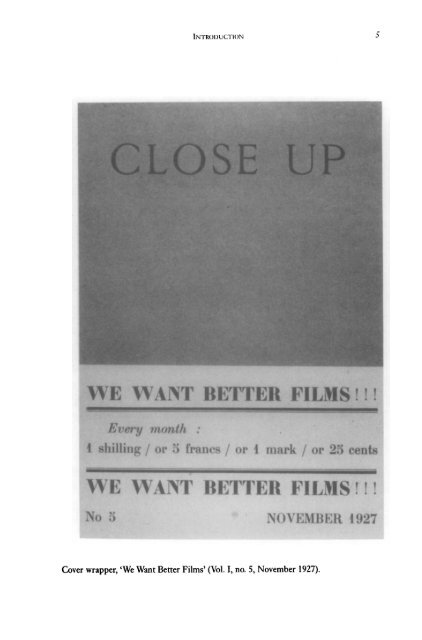close up - Monoskop
close up - Monoskop
close up - Monoskop
Create successful ePaper yourself
Turn your PDF publications into a flip-book with our unique Google optimized e-Paper software.
viii<br />
PREFACE<br />
In the January 1929 issue of Close Up, the frontispiece displays a photograph of<br />
Eisenstein inscribed: 'To K. Macpherson - Editor of the Closest Up to what cinema<br />
should be.' This tribute marked the beginning of a relationship which was as much<br />
writer to editor as it was master to student. Close Up published nine translations<br />
of Eisenstein's writing between May 1929 and June 1933, in addition to a number of<br />
occasional pieces about him and his work. 2 Given the constraints of space, we have<br />
reluctantly decided that republishing Eisenstein's work must take a lower priority than<br />
retrieving less well-known writing. To get a true sense of both the range of writing in<br />
Close Up and the strength of its commitment to Eisenstein's ideas, our selection should<br />
be read in conjunction with the work to be found in Film Form, The Film Sense and<br />
Eisenstein's Selected Writings. 3<br />
The writings of H.D. and Dorothy Richardson are presented in the third and fourth<br />
parts of the book. The majority of H.D.'s contributions are included: her three-part<br />
article on 'The Cinema and the Classics', published between July and November 1927,<br />
and five other articles, although not the poem Projector, published in two parts in July and<br />
October 1927. This is available in her Collected Poems. 4 We have included all Richardson's<br />
'Continuous Performance' columns. We believe that they offer an account of the novelty<br />
and modernity of the experience of cinema which is comparable in its scope to the<br />
pioneering essays being written by Siegfried Kracauer in the same period, and which also<br />
prefigures in intriguing and suggestive ways recent scholarship on cinema and<br />
modernity. 5<br />
The major piece in Part 5 is H.D.'s long essay on the film Borderline (1930), written<br />
and directed by Macpherson and featuring H.D. and Bryher as well as Paul and Eslanda<br />
Robeson among its cast. This was not published in Close Up, but as a separate pamphlet<br />
by Mercury Press. We have included it here not only as another example of H.D.'s critical<br />
writing but also because the film probably represented the ultimate expression of<br />
Macpherson's interest in cinema and because, as a result, the fate of the journal was<br />
intimately bound <strong>up</strong> with the critical response to the film.<br />
Part 6 is devoted to Close Up articles on psychoanalysis and cinema. This work<br />
represented a significant and imaginative departure in exploring the fascination and<br />
possibilities of film. Part 7 illustrates how active Close Up was in attempting to create the<br />
institutions and conditions necessary for a vibrant and radical 'film culture' (to use a term<br />
from the 1970s). Far from being aloof, contributors like Bryher, Dorothy Richardson and<br />
Ralph Bond energetically promoted amateur forms of production and exhibition, and<br />
campaigned against the particularly hidebound censorship in the United Kingdom which<br />
prevented many of the films they valued most highly from being screened.<br />
Our selection represents only a fraction of the work published in Close Up, and quite<br />
properly it reflects our tastes and priorities. We hope, however, that the collection will<br />
contribute to today's debates about the cultural, aesthetic and social consequences of the<br />
technological media in the first half of the twentieth century. It is intended less as an<br />
exercise in the archaeology of film theory than as an attempt to provide a relevant<br />
intellectual and historical context for those debates by showing how the issues were<br />
experienced, imagined and discussed at the time.<br />
This book, perhaps a little like Close Up, is itself the outcome of a three-way editorial<br />
collaboration. When it emerged that Laura Marcus and James Donald in England and

















